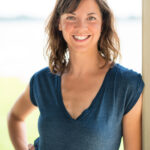Aszure’s Audition Adventure
For many New York City dancers, auditions are part of the weekly regime. But some companies—particularly smaller contemporary ones—now hire dancers through extended workshop/auditions rather than open cattle calls. At open auditions, directors may make cuts within 15 minutes based on looks—or require dancing for hours with no end in sight. A workshop/audition, however, comes with a specific schedule for the day and feels more like a class.
Some performers, like freelance dancer Mayte Natalio, mesh better with the workshop format. “I usually hate auditions,” declares the Queens, New York, native. “I get nervous and don’t feel like I show myself well in just an hour or two.” But at a workshop/audition for choreographer Aszure Barton’s company last October at Peridance, Natalio found herself pleasantly surprised by the process of getting to know Barton’s quirky style. She was one of about 150 dancers who attended morning classes with Barton and among the 50 or so who got called back for a four-hour evening audition. Her experience shows that auditioning isn’t just about getting hired; it can also be a chance to push yourself creatively and get an intimate look at a choreographer’s way of working. DM trailed Natalio and caught up with her afterward.
In the beginning…
Although as a younger dancer Natalio was interested in “just dancing” and strong technique, the 27-year-old now finds herself searching for choreography with emotional depth and complex nuances. For her, Barton’s aesthetic fits the bill. “I love Aszure’s work,” she says. “It’s physical but not just technical. There are stories, subtle humor, and her dancers are amazing.”
Natalio’s career has gotten off to a promising start. After attending LaGuardia High School for the Performing Arts and training at Ballet Hispanico and Dance Theatre of Harlem, she earned her BFA from SUNY Purchase’s Conservatory of Dance. As with many professional dancers, Natalio is open to an array of opportunities, most recently having toured Europe and Russia with French pop star Mylène Farmer. (She is currently represented for commercial work by Bloc talent agency.) She has performed internationally with Parsons Dance Company, freelanced with Nathantrice/RITUALS, and appeared with Camille A. Brown at the Joyce last summer. Her dancing is full of athletic power, without airs or affectation.
Still, Natalio says, putting herself out there isn’t always easy. “My biggest challenges are staying motivated, paying for classes, and finishing one gig while trying to find another,” she says. When she heard about Barton’s audition, she knew that at the very least, she would have the chance to take a free two-hour class.
Step by step
Despite the packed studio (she was vying for space with about 74 other dancers), Natalio felt the morning class went well. One of Barton’s dancers, Jonathan Alsberry, taught tricky vocabulary from the choreographer’s recent work BUSK. One phrase had a series of sharp head movements coupled with unusual spoken counting patterns; another was fast and aggressive with low, animal-like movements. “The workshop process gave me a chance to learn phrases thoroughly,” says Natalio, “even though the counts were definitely confusing!”
After two back-to-back classes, Barton invited about 25 women and 25 men to the evening audition. (Through-out the day, she was assisted by Alsberry; her dancer Emily Oldak; her intern Clea Owens; and her sisters Charissa and Cherice Barton, who also dance in her company.) Natalio was excited to hear her name. “The callback was awesome,” she says. “Normally auditions feel rushed, but the panel took time to see each individual fully.”
Barton’s process, she adds, was as much about cultivating creativity as it was about dancing. After reviewing the morning phrases and having dancers perform them in small groups, Barton asked everyone to sit facing the panel, listen to music, and use their faces as instruments to reflect what they heard. “Not using your body was really challenging,” Natalio says, “but I tried to go for it and not look at anyone—I didn’t want to laugh!”
Later, Barton demonstrated a solo acting exercise, designed to see how the dancers could veer between emotional states. Walking downstage, she made a welcoming gesture and eye contact with each panel member. Then she pointed warily at one of her sisters, pointed at DM’s writer with contempt, slowly changed her expression to love and acceptance, and walked off with a wave. As each dancer put their own spin on the exercise, she asked them not to be dancers, but to scrape away the exterior and be “genuinely you,” which allowed for some interesting (sometimes wacky) interpretations. For Natalio, that meant “showing my loud, high-energy Queens personality—without being forced.”
Finishing on a high note
Rarely is an audition perfect, and for Natalio the partnering section was rough. “I was frustrated because I was partnered with a female about my height, and the lifts weren’t working. It was really fast, and our energies seemed to clash.” But her high point outweighed the low. Towards the end of the evening, just the women were asked to improvise, dancing slowly with their eyes closed. One by one, Barton tapped each woman on the shoulder to sit down, until there was only one dancer left. “It was beautiful watching the last two dancers,” says Natalio, “and the last girl almost started crying when she opened her eyes.”
Although Natalio didn’t make it through the final cut, she left feeling energized instead of discouraged. She is already looking forward to the next opportunity to experience Barton’s process. “I learned a lot, because I could tell that Aszure really cared and gave genuine, specific feedback,” says Natalio. “I found myself really investigating movement, not just dancing as I usually do.”
Jen Peters dances for Jennifer Muller/The Works.
Photo of Mayte Natalio by Lois Greenfield





